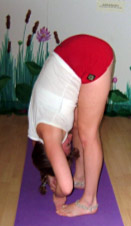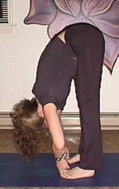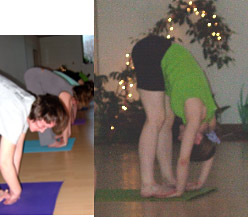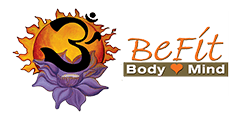Download a guide to this pose. (PDF)
Padangusthasana/Padahastasana
Pada means foot, angustha means thumb, hasta means hand, so the poses translates to thumb to foot pose and hand to foot pose.
Standing forward bends combine the effects of an inverted pose with those of a forward bending pose, using gravity to help release tension and pain. The combination of inversion and forward bending is a powerful means of toning the whole body, as pressure is exerted on all the major endocrine glands –including genitals, adrenals, thymus, thyroid, and parathyroids, pineal and pituitary. Major emphasis is given to the pelvic stretch and Swadhisthana chakra (2nd). Prana is channeled to the lower regions of the body as apana, motivated by the exhale.
Many people live sedentary lives, busy schedules and city living encourage both mental tension and physical rigidity, both of which are counteracted during forward bending. At another level, forward bending is associated bowing and humility, an inability to bend forward may indicate a stiff, proud, or stubborn personality. Difficulty bending forward is also associated with fear. Human beings face forward to see the world, dropping into the forward bend to see behind us releases rigidity and fear.
 |
Method: Padangusthasana:
|
 |
| Padahastasana: **In all forward bending postures, care should be taken to fold from the hips, not the waist. As you fold from the hips it will require a little more effort as you are moving more of your body than when folding at the waist. Performing hip flexion instead of spinal flexion in this pose will protect your intervertebral discs. **
This pose adds the additional benefit to the wrists, counterbalancing the wrists from the upper body weight bearing positions of the sun salutes |
 |
Benefits:
These two poses play in important role in beginning the process of purification. They reduce the accumulation of fat around the waist and abdomen. They work on all the internal organs of the abdomen preventing and curing stomach ailments and constipation (a major factor in the build up of toxins in the body which can trigger the beginning of disease). Forward bends improve digestion and they eliminate flatulence and cleanse the rectum and anus.
They massage the abdominal contents, especially he liver, spleen, and kidneys are toned, they also massage the gall bladder, pancreas, uterus and ovaries.
A good flow of blood is encouraged to the spinal nerves and muscles as they are stretched and toned, during forward bending asana each of the vertebra are separated, stimulating circulation around the spine and nourishing the spinal cord. The hamstring and calf muscles are stretched, relieving varicose veins and aiding the return of blood to the heart.
